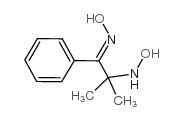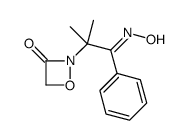5291-08-7
| Name | 2-(hydroxyamino)-2-methyl-1-phenylpropan-1-one oxime |
|---|---|
| Synonyms |
N-<2-Methyl-3-hydroxyimino-3-phenyl-propyl-(2)>-hydroxylamin
3-fluoropyridin-1-ium-1-olate 3-Fluor-pyridin-1-oxid 1-oxido-3-fluoropyridine 3-fluoropyridine N-oxide 3-Fluoropyridine-1-oxide 1-oximino-2-hydroxylamino-1-phenyl-2-methylpropane Pyridine,3-fluoro-,1-oxide N-(2-methyl-1-oximino-1-phenyl-2-propyl)hydroxylamine N-<1-Hydroxyimino-2-methyl-1-phenyl-propyl-(2)>-hydroxylamin OH(H)NCMe2C(Ph)=NOH 1-oximino-2-hydroxylamino-1-phenyl-2-methylpropan |
| Density | 1.12g/cm3 |
|---|---|
| Boiling Point | 363ºC at 760 mmHg |
| Melting Point | 153-154ºC |
| Molecular Formula | C10H14N2O2 |
| Molecular Weight | 194.23000 |
| Flash Point | 173.3ºC |
| Exact Mass | 194.10600 |
| PSA | 64.85000 |
| LogP | 2.01320 |
| Index of Refraction | 1.538 |
Synonym: Section 2 - COMPOSITION, INFORMATION ON INGREDIENTS
Risk Phrases: 34 Section 3 - HAZARDS IDENTIFICATION EMERGENCY OVERVIEW
Causes burns. Potential Health Effects Eye: Causes eye burns. Skin: Causes skin burns. Ingestion: Causes gastrointestinal tract burns. Inhalation: Causes chemical burns to the respiratory tract. Chronic: Not available. Section 4 - FIRST AID MEASURES Eyes: Immediately flush eyes with plenty of water for at least 15 minutes, occasionally lifting the upper and lower eyelids. Get medical aid immediately. Skin: Get medical aid immediately. Immediately flush skin with plenty of water for at least 15 minutes while removing contaminated clothing and shoes. Ingestion: Do not induce vomiting. Get medical aid immediately. Inhalation: Get medical aid immediately. Remove from exposure and move to fresh air immediately. If not breathing, give artificial respiration. If breathing is difficult, give oxygen. Notes to Physician: Treat symptomatically and supportively. Section 5 - FIRE FIGHTING MEASURES General Information: As in any fire, wear a self-contained breathing apparatus in pressure-demand, MSHA/NIOSH (approved or equivalent), and full protective gear. Extinguishing Media: Use foam, dry chemical, or carbon dioxide. Section 6 - ACCIDENTAL RELEASE MEASURES General Information: Use proper personal protective equipment as indicated in Section 8. Spills/Leaks: Vacuum or sweep up material and place into a suitable disposal container. Section 7 - HANDLING and STORAGE Handling: Do not breathe dust, vapor, mist, or gas. Do not get in eyes, on skin, or on clothing. Use only in a chemical fume hood. Storage: Store in a cool, dry place. Store in a tightly closed container. Corrosives area. Section 8 - EXPOSURE CONTROLS, PERSONAL PROTECTION Engineering Controls: Facilities storing or utilizing this material should be equipped with an eyewash facility and a safety shower. Use adequate ventilation to keep airborne concentrations low. Exposure Limits CAS# 5291-08-7: Personal Protective Equipment Eyes: Not available. Skin: Wear appropriate protective gloves to prevent skin exposure. Clothing: Wear appropriate protective clothing to prevent skin exposure. Respirators: Follow the OSHA respirator regulations found in 29 CFR 1910.134 or European Standard EN 149. Use a NIOSH/MSHA or European Standard EN 149 approved respirator if exposure limits are exceeded or if irritation or other symptoms are experienced. Section 9 - PHYSICAL AND CHEMICAL PROPERTIES Physical State: Solid Color: white Odor: Not available. pH: Not available. Vapor Pressure: Not available. Viscosity: Not available. Boiling Point: Not available. Freezing/Melting Point: 153 - 154 deg C Autoignition Temperature: Not available. Flash Point: Not available. Explosion Limits, lower: Not available. Explosion Limits, upper: Not available. Decomposition Temperature: Solubility in water: Specific Gravity/Density: Molecular Formula: C10H14N2O2 Molecular Weight: 194 Section 10 - STABILITY AND REACTIVITY Chemical Stability: Not available. Conditions to Avoid: Incompatible materials. Incompatibilities with Other Materials: Oxidizing agents. Hazardous Decomposition Products: Nitrogen oxides, carbon monoxide, carbon dioxide. Hazardous Polymerization: Has not been reported Section 11 - TOXICOLOGICAL INFORMATION RTECS#: CAS# 5291-08-7 unlisted. LD50/LC50: Not available. Carcinogenicity: 2-(Hydroxyamino)-2-methyl-1-phenylpropan-1-one oxime - Not listed by ACGIH, IARC, or NTP. Section 12 - ECOLOGICAL INFORMATION Section 13 - DISPOSAL CONSIDERATIONS Dispose of in a manner consistent with federal, state, and local regulations. Section 14 - TRANSPORT INFORMATION IATA Shipping Name: AMINES, SOLID, CORROSIVE, N.O.S.* Hazard Class: 8 UN Number: 3259 Packing Group: III IMO Shipping Name: AMINES, SOLID, CORROSIVE, N.O.S. Hazard Class: 8 UN Number: 3259 Packing Group: III RID/ADR Shipping Name: AMINES, SOLID, CORROSIVE, N.O.S. Hazard Class: 8 UN Number: 3259 Packing group: III Section 15 - REGULATORY INFORMATION European/International Regulations European Labeling in Accordance with EC Directives Hazard Symbols: C Risk Phrases: R 34 Causes burns. Safety Phrases: S 26 In case of contact with eyes, rinse immediately with plenty of water and seek medical advice. S 36/37/39 Wear suitable protective clothing, gloves and eye/face protection. S 45 In case of accident or if you feel unwell, seek medical advice immediately (show the label where possible). WGK (Water Danger/Protection) CAS# 5291-08-7: No information available. Canada None of the chemicals in this product are listed on the DSL/NDSL list. CAS# 5291-08-7 is not listed on Canada's Ingredient Disclosure List. US FEDERAL TSCA CAS# 5291-08-7 is not listed on the TSCA inventory. It is for research and development use only. SECTION 16 - ADDITIONAL INFORMATION N/A |
| Hazard Codes | Xi |
|---|---|
| Risk Phrases | R34 |
| Safety Phrases | S26-S36/37/39-S45 |
| HS Code | 2928000090 |
| Precursor 0 | |
|---|---|
| DownStream 2 | |
| HS Code | 2928000090 |
|---|---|
| Summary | 2928000090 other organic derivatives of hydrazine or of hydroxylamine VAT:17.0% Tax rebate rate:9.0% Supervision conditions:none MFN tariff:6.5% General tariff:20.0% |

![[(1-hydroxyimino-2-methyl-1-phenylpropan-2-yl)amino] 2-chloroacetate structure](https://image.chemsrc.com/caspic/461/84439-68-9.png)
